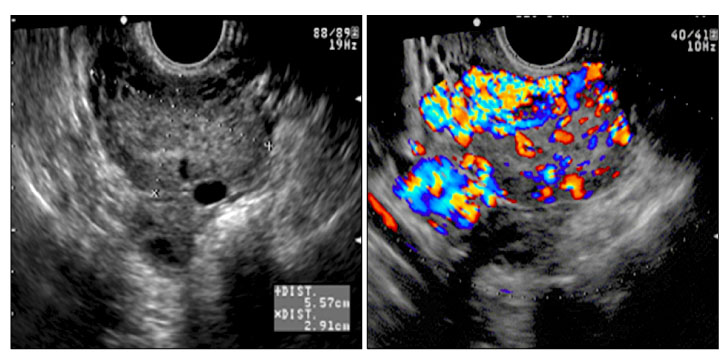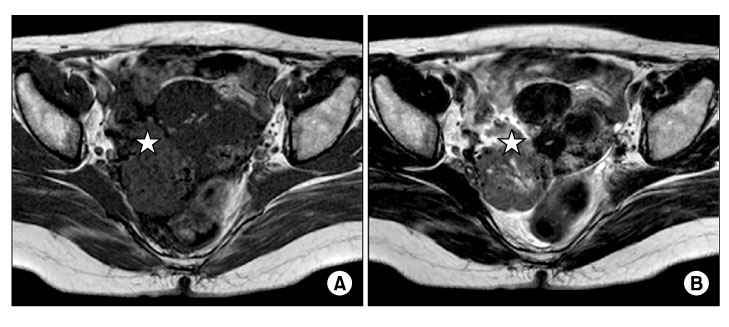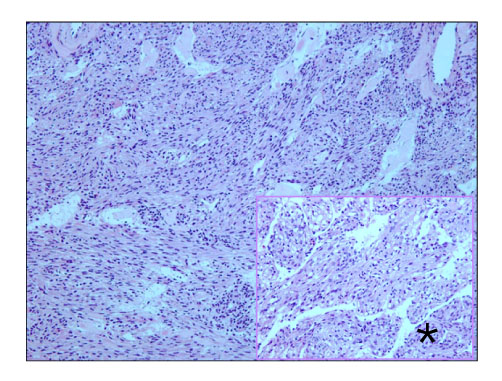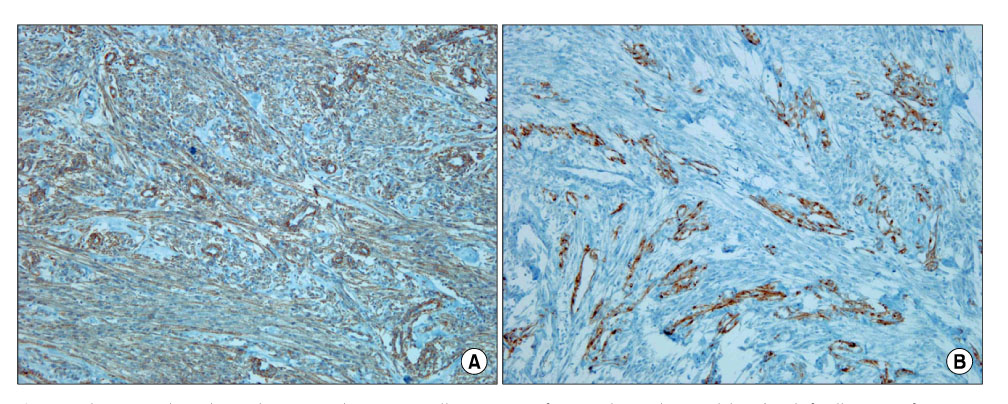J Gynecol Oncol.
2008 Sep;19(3):195-198. 10.3802/jgo.2008.19.3.195.
A case of lymphangioleiomyomatosis originated in the pelvic cavity
- Affiliations
-
- 1Department of Obstetrics and Gynecology, Hallym University Medical College, Anyang, Korea. icastle@hallym.or.kr
- 2Department of Pathology, Hallym University Medical College, Anyang, Korea.
- KMID: 2173402
- DOI: http://doi.org/10.3802/jgo.2008.19.3.195
Abstract
- Lymphangioleiomyomatosis is a rare disease that is characterized by proliferation of abnormal smooth muscle-like cells, especially that which occurs in the pulmonary parenchyme. It primarily affects women of child-bearing age. The majority of primary lymphangioleiomyomatosis occurs in the lung, but there are a few reports of extrapulmonary cases. We experienced a rare case of lymphangioleiomyomatosis which originated in the pelvic cavity (in the posterior portion of the uterus), and report with brief review of literatures.
Keyword
Figure
Reference
-
1. Johnson SR, Tattersfield AE. Clinical experience of lymphangioleiomyomatosis in the UK. Thorax. 2000. 55:1052–1057.2. Ryu JH, Moss J, Beck GJ, Lee JC, Brown KK, Chapman JT, et al. The NHLBI Lymphangioleiomyomatosis Registry: Characteristics of 230 patients at enrollment. Am J Respir Crit Care Med. 2006. 173:105–111.3. Matsui K, Tatsuguchi A, Valencia J, Yu Z, Bechtle J, Beasley MB, et al. Extrapulmonary lymphangioleiomyomatosis (LAM): Clinicopathologic features in 22 cases. Hum Pathol. 2000. 31:1242–1248.4. Zamboni G, Pea M, Martignoni G, Zancanaro C, Faccioli G, Gilioli E, et al. Clear cell "sugar" tumor of the pancreas. A novel member of the family of lesions characterized by the presence of perivascular epithelioid cells. Am J Surg Pathol. 1996. 20:722–730.5. Kitaichi M, Nishimura K, Itoh H, Izumi T. Pulmonary lymphangiomyomatosis: A report of 46 patients including a clinicopathologic study of prognostic factors. Am J Respir Crit Care Med. 1995. 151:527–533.6. Chu SC, Horiba K, Usuki J, Avila NA, Chen CC, Travis WD, et al. Comprehensive evaluation of 35 patients with lymphangioleiomyomatosis. Chest. 1999. 115:1041–1052.7. Jaiwal VR, Baird J, Fleming J, Miller DS, Sharma S, Molberg K. Localized retroperitoneal lymphangioleiomyomatosis mimicking malignancy. Arch Pathol Lab Med. 2003. 127:879–882.8. Kim HS, Park MI, Suh KS. Lymphangiomyomatosis arising in the pelvic cavity: A case report. J Korean Med Sci. 2005. 20:904–907.9. Taveira-DaSilva AM, Steagall WK, Moss J. Lymphangioleiomyomatosis. Cancer Control. 2006. 13:276–285.10. McCormack FX. Lymphangioleiomyomatosis: A clinical update. Chest. 2008. 133:507–516.11. Carsillo T, Astrinidis A, Henske EP. Mutations in the tuberous sclerosis complex gene TSC2 are a cause of sporadic pulmonary lymphangioleiomyomatosis. Proc Natl Acad Sci U S A. 2000. 97:6085–6090.12. Ohori NP, Yousem SA, Sonmez-Alpan E, Colby TV. Estrogen and progesterone receptors in lymphangioleiomyomatosis, epithelioid hemangioendothelioma, and sclerosing hemangioma of the lung. Am J Clin Pathol. 1991. 96:529–535.13. Brunelli A, Catalini G, Fianchini A. Pregnancy exacerbating unsuspected mediastinal lymphangioleioyomatosis and chylothorax. Int J Gynaecol Obstet. 1996. 52:289–290.14. Yano S. Exacerbation of pulmonary lymphangioleiomyomatosis by exogenous oestrogen used for infertility treatment. Thorax. 2002. 57:1085–1086.15. Sieker HO, McCarty KS Jr. Lymphangiomyomatosis: A respiratory illness with an endocrinologic therapy. Trans Am Clin Climatol Assoc. 1987. 99:57–67.16. Harari S, Cassandro R, Chiodini J, Taveira-DaSilva AM, Moss J. Effect of a gonadotrophin-releasing hormone analogue on lung function in lymphangioleiomyomatosis. Chest. 2008. 133:448–454.17. Rossi GA, Balbi B, Oddera S, Lantero S, Ravazzoni C. Response to treatment with an analog of luteinizing-hormone-releasing hormone in a patient with pulmonary lymphangioleiomyomatosis. Am Rev Respir Dis. 1991. 143:174–176.18. Sullivan EJ. Lymphangioleiomyomatosis: A review. Chest. 1998. 114:1689–1703.
- Full Text Links
- Actions
-
Cited
- CITED
-
- Close
- Share
- Similar articles
-
- Recurrent Pneumothorax Caused by an Unexpected Lymphangioleiomyomatosis: A Case Report
- CT and MR Imaging Findings of Lymphangioleiomyomatosis Involving the Uterus and Pelvic Cavity
- Pulmonary Lymphangioleiomyomatosis with Chylous Pleural Effusion
- Schwannoma Originated from Obturator Nerve of Pelvic Cavity in Patient with Urinary Frequency
- Ganglioneuroma in Pelvic Cavity





